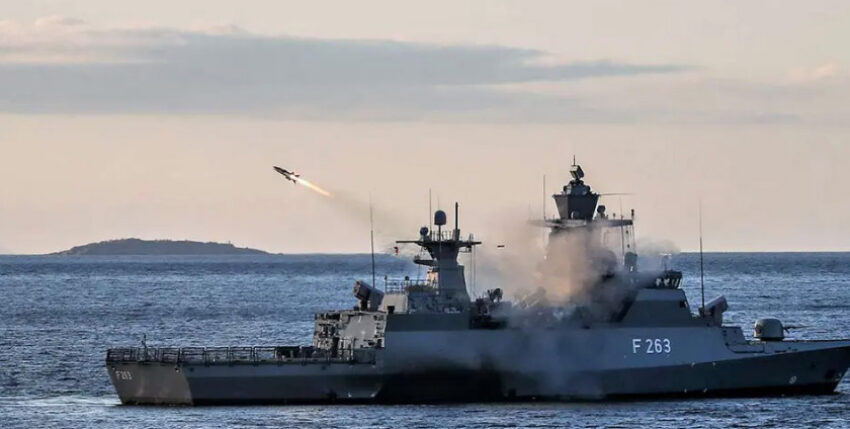The RBS 15 Mk 3 guided missile has been in service with the German naval forces together with its weapon platform, the class 130 corvettes, since 2008. Due to the comparatively heavy weight of its warhead, it is categorised as a heavy naval missile. It can be used against both sea and land targets, for example against military infrastructure or missile launchers. The target data is generally not provided by the corvettes' own sensors, but by other sources, such as shore-based forces deployed as spotters or the Sea Falcon drone deployed on corvettes.
Until now, the corvettes had only fired the heavy anti-ship missile against sea targets. Now, as part of the Missile Firing Exercise (MFE) 2022 in northern Norway, the corvette Oldenburg with the Echo crew has demonstrated that the RBS 15 can also be used against land targets relatively far behind the coastline. Ultimately, the aim is to establish the missile as an effective weapon not only at sea, but also on land, in order to ensure that the German Navy can participate on an equal footing in joint targeting.
The deep contour flight of the missile over land required careful preparation and exceptional safety measures. The entire sea area was closed to civilian shipping and air traffic. In addition, the Norwegian authorities had to evacuate several residential buildings along the flight path, close a public road and deploy helicopters with thermal imaging cameras before firing to ensure that there were no people in the area. With this proof, the Oldenburg was practising for operations in the coastal apron, i.e. in shallow and narrow waters in which the manoeuvrable Class 130 corvettes with their relatively shallow draught can operate flexibly. Immediately after firing, the corvette left its firing position, just as it would under real operating conditions.

The RBS 15 flew a challenging route over both sea and land, making good use of its range of over 200 kilometres. During the entire flight route, it made several hooks over various waypoints and also changed its flight altitude. This type of flight behaviour is intended to conceal the launch site and thus the position of the corvette from a potential enemy. For this project, the missile did not carry a live warhead, but a type of telemetry head with special sensors and a transmitter to record and transmit its flight data precisely.
Finally, the RBS 15 hit a target garden consisting of several containers on an island in the firing range around Andøya. The commander of the Oldenburg, Corvette Captain Dohnke, was extremely satisfied with the deployment procedure and flight behaviour of the RBS 15, stating that the missile behaved exactly as it was designed for its mission. For Dohnke, the manoeuvre was therefore a complete success: "We were finally able to demonstrate the use of the RBS 15 against land targets, which is fundamental and characterising for the corvette weapon system, and once again proved the combat power and performance of our ships. We are bringing the experience we have gained back to Germany for the 1st Corvette Squadron and thus for the entire Navy."
In future, the corvettes will continue to participate in the Missile Firing Exercise. The aim is to expand the tactical operational spectrum of the RBS 15 deployment and to move from static system firing to dynamic troop firing with the coordinated use of weapons by two units. The Sea Falcon reconnaissance drone, which is intended for the corvettes, will effectively expand the tactical operational spectrum of the ships.
Oberleutnant zur See Nils Stockfisch is deck officer of the crew K 130 Echo.








